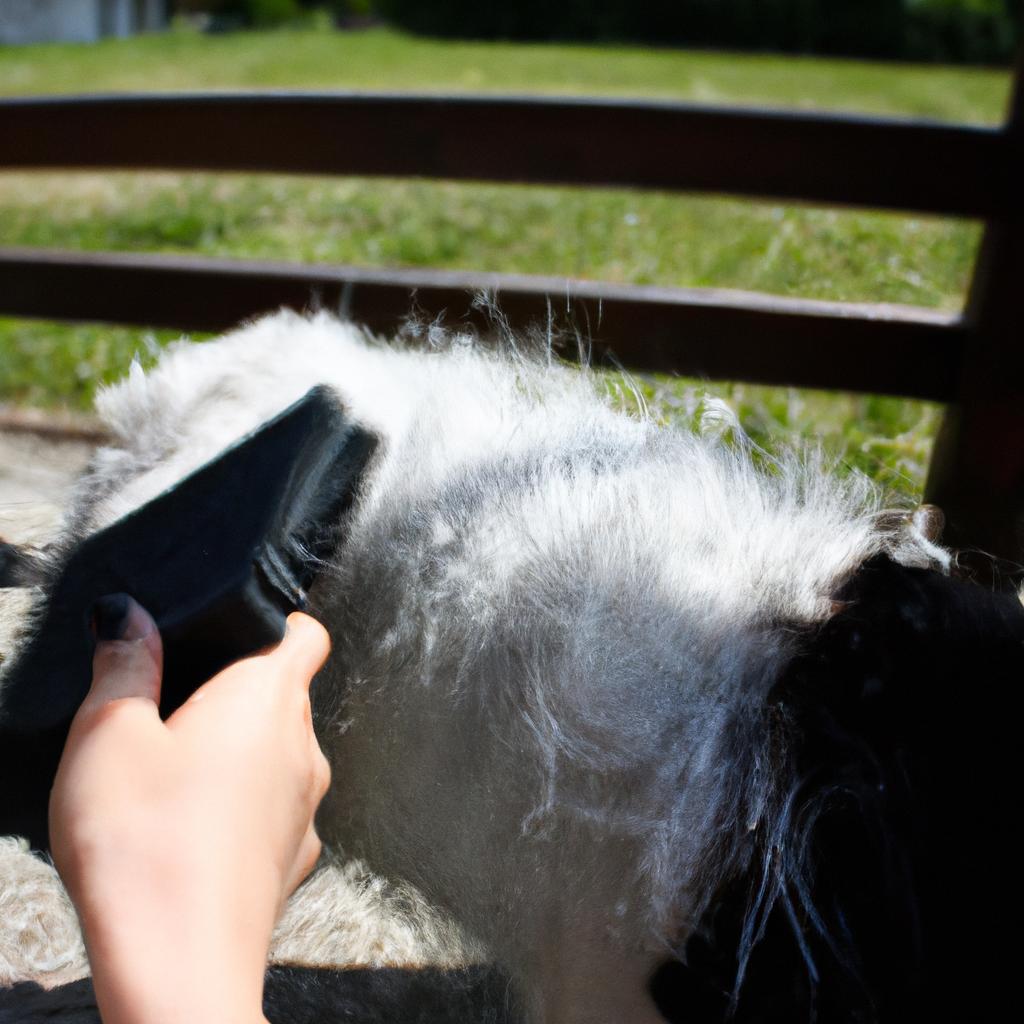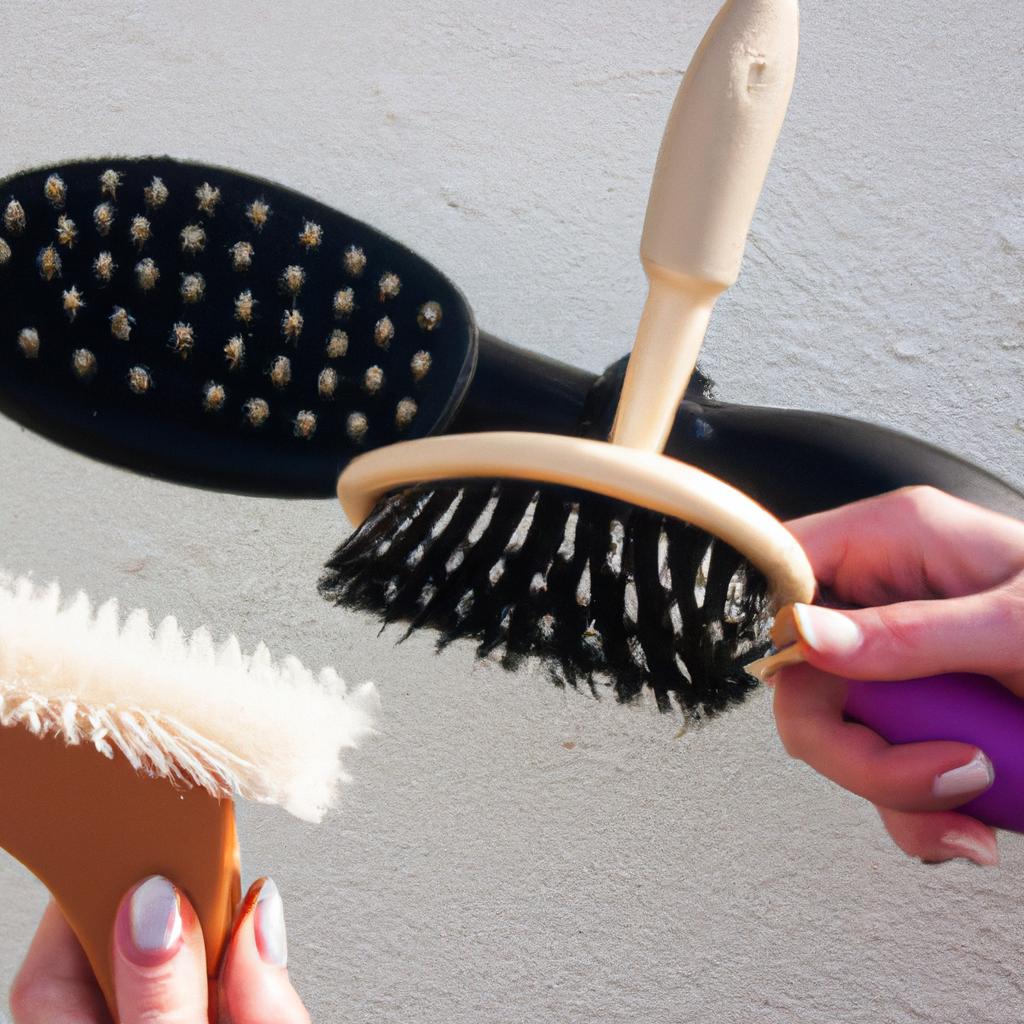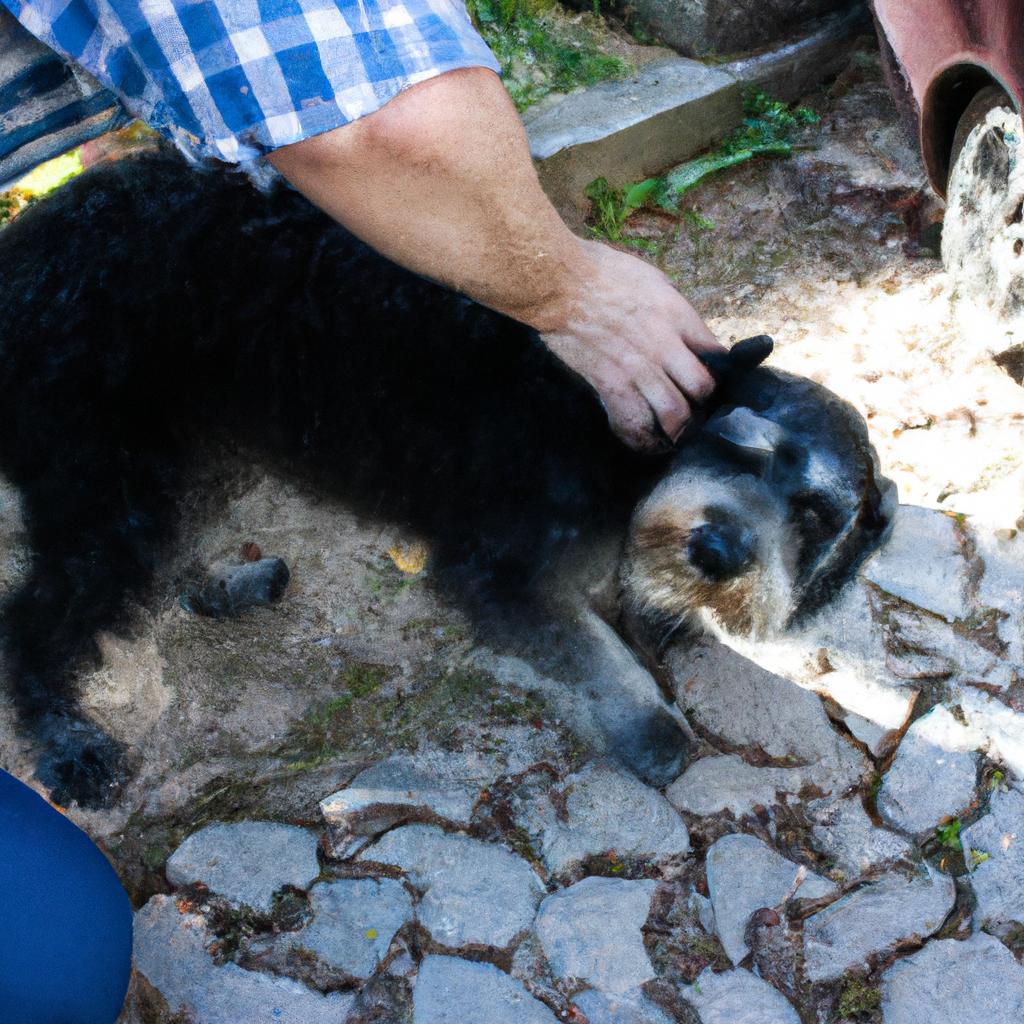Preventing Coat Matting: A Guide to Effective Coat Brushing in the Dog Grooming Salon

Coat matting is a common issue faced by dog owners and groomers alike. Imagine a scenario where a client brings in their beloved Golden Retriever, Max, for his routine grooming appointment. However, upon inspection, the groomer discovers that Max’s coat is severely matted, making it difficult to properly clean and maintain. This situation not only poses challenges for the groomer but also causes discomfort and potential health risks for the dog. In order to address this problem effectively, it is essential for dog grooming salons to implement proper coat brushing techniques. By doing so, they can prevent matting and ensure the overall well-being of dogs under their care.
Proper coat brushing serves as an indispensable tool in preventing matting issues in the dog grooming salon setting. Matting occurs when loose hair becomes entangled with other strands or debris within the coat. If left unaddressed, these mats can lead to various problems such as skin irritation, restricted movement, and even infection. Therefore, understanding how to effectively brush different types of coats is crucial for maintaining healthy and comfortable pets.
To provide practical guidance on effective coat brushing techniques in the dog grooming salon, this article will explore various factors that contribute to mat formation and discuss appropriate strategies for prevention.
Understanding the Importance of Regular Brushing
Coat matting is a common issue faced by dog owners and groomers alike. It occurs when the hair becomes tangled, knotted, and compacted, resulting in discomfort for the dog and potential health problems if left unattended. To illustrate this point, let us consider a hypothetical scenario: imagine a golden retriever named Max who has not been brushed regularly. His long, luxurious coat starts to develop mats near his hind legs due to constant friction with furniture and lack of proper grooming. As time goes on, these mats become tighter and more painful for Max, leading to skin irritation and even infection.
Regular brushing plays a crucial role in preventing coat matting and maintaining a healthy coat for our canine companions. By following recommended brushing techniques tailored to each specific breed’s needs, we can help minimize mat formation and ensure that our furry friends stay comfortable and happy. Here are four key reasons why regular brushing is essential:
-
Prevents discomfort: Regularly brushing your dog’s coat helps remove loose fur, dirt, debris, and tangles. This prevents the hair from becoming matted or tangled, which can cause pain and discomfort for your pet.
-
Promotes healthy skin: Brushing stimulates blood circulation to the skin’s surface while distributing natural oils throughout the coat. These oils keep the skin moisturized and prevent dryness or flakiness.
-
Reduces shedding: Dogs naturally shed their coats as new hair grows in its place. Regular brushing removes excess dead hair before it ends up all over your house or clothing.
-
Enhances bonding: Brushing sessions provide an excellent opportunity for you to bond with your furry friend while giving them some much-needed attention and care.
To better understand how different breeds may require varying levels of maintenance when it comes to brushing their coats effectively, refer to Table 1 below:
Table 1: Coat Types & Recommended Brushing Frequency
| Coat Type | Recommended Brushing Frequency |
|---|---|
| Short | Weekly |
| Medium | Every few days |
| Long | Daily |
By identifying the appropriate brushing frequency for your dog’s coat type, you can ensure they receive the care they need to maintain a healthy and mat-free coat.
Transitioning into the subsequent section on “Choosing the Right Brush for Your Dog’s Coat Type,” it is essential to understand that using an appropriate brush plays a vital role in achieving effective results. So, let us explore how selecting the right brush can make all the difference in maintaining your beloved pet’s coat health.
Choosing the Right Brush for Your Dog’s Coat Type
Now, let’s explore how to choose the right brush specifically tailored to your dog’s unique coat type.
Imagine you have a Shih Tzu named Bella with long and silky hair that tends to get easily tangled and matted. To prevent her coat from becoming unmanageable, it is crucial to select the appropriate brush for her needs.
When choosing a brush for your dog’s coat type, consider the following factors:
-
Coat Length: Different brushes are designed to handle varying lengths of fur. For example:
- Short coats may benefit from soft bristle brushes or rubber curry brushes.
- Long coats often require slicker brushes or pin brushes with longer bristles.
- Double-coated breeds may need undercoat rakes or deshedding tools.
-
Coat Texture: The texture of your dog’s fur also plays a role in determining the ideal brush:
- Fine-textured coats may be suited for slicker brushes or combs with fine teeth.
- Coarse or wiry coats might require stiff-bristled brushes or de-matting tools.
- Curly or wavy coats can benefit from wide-toothed combs or detangling sprays.
-
Sensitivity: Consider your dog’s sensitivity when selecting a brush:
- Dogs with sensitive skin may prefer softer bristles or grooming gloves.
- Rubber curry brushes are gentle options for dogs who dislike traditional brushing.
-
Personal Preference: Ultimately, finding the right brush involves trial and error based on both your preferences as an owner and what works best for your dog.
Table: Common Brushes Based on Coat Type
| Coat Type | Recommended Brushes |
|---|---|
| Short | Soft bristle brush |
| Long | Slicker brush, pin brush |
| Double-coated | Undercoat rake, deshedding tool |
| Fine-textured | Slicker brush, fine-toothed comb |
| Coarse or wiry | Stiff-bristled brush, de-matting tool |
| Curly or wavy | Wide-toothed comb, detangling spray |
By understanding your dog’s coat type and selecting the appropriate brush accordingly, you can ensure that grooming sessions are effective in preventing matting and maintaining a healthy coat. In our next section, we will delve into proper techniques for brushing your dog’s coat to achieve optimal results.
Now that we have explored how to choose the right brush for your dog’s unique coat type, let us move on to discussing the proper technique for brushing their coat effectively.
Proper Technique for Brushing Your Dog’s Coat
With the right brush in hand, you are now ready to tackle the task of brushing your dog’s coat. By following proper technique and incorporating regular brushing into your grooming routine, you can effectively prevent coat matting and keep your furry friend looking their best.
Paragraph 1:
Let us consider a hypothetical scenario to illustrate the importance of effective coat brushing. Imagine a Golden Retriever named Max who loves playing outdoors and often finds himself rolling around in grassy fields. Without consistent brushing, Max’s long, thick fur becomes prone to matting due to dirt, debris, and tangled hairs that go unnoticed. As a responsible pet owner or groomer, it is crucial to stay on top of his grooming needs by implementing an effective brushing routine.
To help guide you through this process, here are some key techniques for successful coat brushing:
- Start with gentle strokes: Begin by using light pressure when brushing your dog’s coat. This will allow you to identify any tangles or knots without causing discomfort or pain.
- Work in sections: Divide your dog’s coat into manageable sections and focus on one area at a time. This approach ensures thoroughness while preventing overwhelming both you and your canine companion.
- Use appropriate brush strokes: Depending on your dog’s coat type, choose the appropriate brush stroke direction. For example, use long, smooth strokes for dogs with straight hair and shorter strokes against the grain for those with curly or wiry hair.
- Pay attention to sensitive areas: Be extra cautious when working around sensitive areas such as ears, belly, tail base, and armpits. These spots require gentle handling to avoid any potential irritation or injury.
Bullet Point List (evoking emotional response):
Regular brushing offers numerous benefits for both you and your furry friend:
- Promotes bonding between you and your dog
- Helps maintain healthy skin by distributing natural oils
- Reduces shedding and prevents excess hair from accumulating in your home
- Provides an opportunity to check for any skin abnormalities or parasites
Table (evoking emotional response):
| Brush Type | Suitable Coat Types | Benefits |
|---|---|---|
| Slicker brush | Long-haired and curly coats | Removes loose hair and prevents matting |
| Bristle brush | Short-haired and smooth coats | Stimulates the skin and improves shine |
| Undercoat rake | Breeds with thick undercoats | Reduces shedding by removing loose fur |
| Mat comb | Dogs prone to tangling | Safely detangles matted areas of the coat |
Paragraph 2:
By incorporating these techniques into your brushing routine, you can ensure that your dog’s coat remains healthy, clean, and tangle-free. Regularly scheduled grooming sessions will not only prevent matting but also create a bonding experience between you and your pet. Remember, consistency is key when it comes to maintaining a well-groomed appearance for your furry companion.
Now equipped with the knowledge of effective brushing techniques, let us move on to the next step in our comprehensive grooming guide – identifying and addressing coat tangles and knots.
Identifying and Addressing Coat Tangles and Knots
Imagine a scenario where a dog grooming salon is bustling with activity. In one corner, a professional groomer carefully brushes through the thick coat of a Golden Retriever named Max. As she works her way from head to tail, using proper brushing technique, Max’s coat shines and flows effortlessly. This example illustrates the importance of mastering the art of proper coat brushing technique in preventing matting and maintaining a healthy coat for our furry friends.
To ensure effective coat brushing, it is crucial to follow these key guidelines:
-
Start at the base: Begin by gently combing or brushing out any tangles or knots near the skin before moving towards the outer layers of fur. This approach prevents unnecessary pulling and discomfort for your pet.
-
Use appropriate tools: Choosing the right brush or comb for your dog’s specific coat type is essential. Different breeds require different grooming tools such as slicker brushes, pin brushes, undercoat rakes, or deshedding tools. Consulting a professional groomer can help you determine which tool will work best for your dog’s unique needs.
-
Work systematically: Divide your dog’s body into sections and work methodically from one section to another. By doing so, you can ensure that no areas are missed while also avoiding over-brushing certain parts of their body.
-
Be gentle yet thorough: Maintain a gentle touch throughout the brushing process to prevent any discomfort or irritability in your dog. However, be thorough enough to remove loose hair and debris effectively.
Table: Benefits of Effective Coat Brushing
| Benefit | Description |
|---|---|
| Prevents Matting | Regular brushing removes loose hairs and prevents them from tangling together into mats. |
| Promotes Healthy Skin | Brushing improves blood circulation in the skin, distributing natural oils for healthier coats. |
| Strengthens Bond with Owner | Brushing sessions provide an opportunity for bonding, trust-building, and quality time together. |
| Early Detection of Skin Issues | Regular brushing allows owners to identify any abnormalities or skin issues at an early stage. |
By following these guidelines and understanding the benefits of effective coat brushing, you can ensure your dog’s coat remains healthy and mat-free.
Now let’s delve into some valuable tips on how to prevent coat matting in dogs.
Tips for Preventing Coat Matting in Dogs
Example: Let’s consider a hypothetical scenario where a Golden Retriever named Max visits a dog grooming salon. Max has long, thick fur that is prone to matting if not properly cared for. The groomer understands the importance of effective coat brushing techniques to prevent matting and ensure Max’s coat remains healthy and beautiful.
To achieve optimal results during coat brushing sessions, there are several key techniques that professional groomers employ:
-
Start with proper preparation:
- Thoroughly inspect the dog’s coat for any tangles or knots.
- Use detangling spray or conditioner on areas prone to matting.
- Ensure all necessary tools such as slicker brushes, combs, and dematting tools are readily available.
-
Utilize gentle yet firm brush strokes:
- Begin brushing from the ends of the hair strands, gradually working towards the roots.
- Apply moderate pressure while brushing to effectively remove loose hairs and prevent tangling.
- Avoid pulling or yanking on the coat, as this may cause discomfort or skin irritation.
-
Adopt an organized approach:
- Divide the dog’s coat into sections and work on one section at a time.
- Focus on removing tangles and knots first before proceeding to overall brushing.
- Regularly clean out excessive hair from brushes to maintain their effectiveness.
-
Provide positive reinforcement:
| Positive Reinforcement Methods | Examples |
|---|---|
| Verbal praise | “Good boy/girl!” |
| Treats | Reward your dog with small treats after each successful brushing session. |
| Gentle petting | Stroke your dog gently when they remain calm during the process. |
By incorporating these techniques into their grooming routine, professionals can help dogs like Max avoid painful matting issues while making the experience more enjoyable for both the dog and groomer.
Transitioning into the subsequent section on “Scheduling Regular Grooming Sessions for Coat Maintenance,” it is essential to establish a consistent grooming schedule to maintain a healthy and tangle-free coat.
Scheduling Regular Grooming Sessions for Coat Maintenance
Building upon the previous tips, it is crucial for dog owners and professional groomers alike to schedule regular grooming sessions. By adhering to a consistent routine, pet parents can ensure their furry friends’ coat health and prevent matting from becoming a persistent issue. In this section, we will explore the importance of scheduling these maintenance appointments and how they contribute to overall coat well-being.
Example:
Consider a scenario where an owner neglects to schedule regular grooming sessions for their long-haired dog. As time passes, the fur becomes tangled and matted, causing discomfort and potential skin irritations. The neglected coat now requires extensive brushing, which puts undue stress on both the pet and the groomer during subsequent visits.
Paragraph 1:
To avoid such situations, here are several reasons why scheduling regular grooming sessions is essential:
- Maintaining coat hygiene: Regular grooming allows thorough inspection of your dog’s coat for any signs of pests or parasites that may go unnoticed otherwise.
- Promoting healthy skin: Consistent brushing stimulates blood circulation in your pet’s skin, promoting its overall health and appearance.
- Strengthening bond with your pet: Grooming sessions provide an opportunity for bonding between you and your four-legged companion.
- Minimizing shedding: Routine brushing helps remove loose hairs before they accumulate throughout your home.
Bullet Point List (Emotional Appeal):
Regular grooming sessions offer numerous benefits not only to your dog but also to you as their caregiver:
- Enhances your dog’s physical comfort
- Reduces the risk of painful tangles
- Improves overall cleanliness
- Creates positive experiences leading to reduced anxiety levels
Table (Emotional Appeal):
Below is an overview highlighting some key advantages of regularly scheduled grooming sessions:
| Advantages of Regular Grooming Sessions |
|---|
| Enhances overall coat health |
| Prevents matting and tangling |
| Promotes early detection of skin issues |
| Creates a more pleasant grooming experience |
Paragraph 2:
By adhering to a consistent schedule, you ensure that your dog’s coat receives the care it needs. Maintaining regularity allows for effective preventive measures against matting, reducing discomfort and potential complications in the long run. Additionally, grooming sessions present an excellent opportunity to assess any changes or abnormalities in your pet’s fur condition.
Incorporating these practices into your routine will not only improve the well-being of your furry friend but also contribute to fostering a strong bond between you as their caregiver and them as your beloved companion.
Please let me know if there is anything else I can assist you with!






